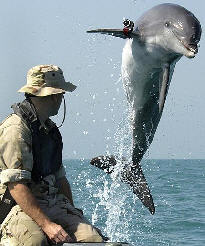|
Trained dolphins assist in mine location
War in Iraq
MilitaryCity.com
27th March 2003
By Tim Friend
USA Today
The Navy has deployed an undisclosed number of “marine mammal systems” to hunt down mines in the Persian Gulf at the southern Iraqi port of Umm Qasr.
The systems, known in non-military circles as bottlenose Atlantic dolphins, are trained to recognize mines using their sensitive echo-locating sonar and to mark the locations of mines with special buoys.
The dolphins are part of Navy Special Clearance Team One, which specializes in mine countermeasures for Navy and coalition vessels. Air Force Maj. Gen. Victor Renuart of Central Command told reporters Tuesday that dolphins already have started searching for mines at Umm Qasr.
Mine clearance is necessary to ensure the safety of U.S. and coalition ships as well as ships carrying humanitarian aid to the Iraqi people.
Tuesday’s deployment marks the first time dolphins have been called to war to conduct mine clearance operations, said Tom Lapuzza, spokesman at Space and Naval Warfare Systems Center in San Diego.
“We do this all the time for training in different parts of the world, but we have never taken mine-hunting dolphins to a war zone,” Lapuzza said.
Dolphins were used during Operation Desert Storm and the Vietnam War for “swimmer defense.” They were trained to search for scuba divers who might have been trying to plant explosives on Navy vessels. The Navy also works with sea lions, which have learned to attach leg restraints to human interlopers they detect.
At least two dolphins, Makai and Takoma, are taking part in the current mission. Lappuza would not disclose the numbers of animals involved.
Capt. Mike Tillotson, a Navy bomb disposal expert, said the dolphins are trained to avoid touching the mines. Animal rights groups have been critical of the Navy’s use of dolphins since its Marine Mammal Program began in 1960 with a single female Pacific white-sided dolphin. But the National Marine Fisheries Service, which oversees the Navy’s marine mammal wards, has reported that Navy dolphin survival rates are 95 percent to 97 percent for the past decade, the highest of any group holding captive dolphins, including academic centers and Sea World. Survival rates in the wild are 92 percent to 95 percent.
The Navy currently employs about 75 dolphins, which are paid for their duties in fish. One of the animals has been involved in the Marine Mammal Program for about 30 years. Lapuzza says only positive reinforcement is used during training.
The animals live in roped off areas of the bay at San Diego and in similar open areas at other training sites. They are trained without tethers in the open ocean almost daily. In 30 years of training, only seven dolphins have gone AWOL, and that was due to animals and trainers becoming separated during bad weather.
Dolphins are important to the Navy because nature has done a much better job evolving echolocation systems than any designed by engineers. A dolphin’s sonar is so sensitive that it can detect a metal disc the size of a quarter 100 feet away.
The dolphin locates an object by emitting a pulse of sound from a specialized structure in its head, called the melon, and waiting for the echo of the sound to return after it strikes an object. The pulse is usually called a click. As the dolphin gets closer to an object, the clicks are made at shorter intervals. When a dolphin is investigating an object at close range, the clicks sound like a buzz. Dolphins are able to form mental pictures based on the echolocation patterns made by an object.
The Navy is developing unmanned robots to do the same job, but they are still no match for the sensitivity of dolphin sonar. The only animal on earth known to have a higher range of hearing is the bat.
Top
|
